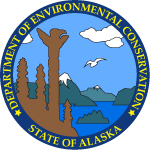| Action Date |
Action |
Description |
DEC Staff |
| 6/11/2003 |
Meeting or Teleconference Held |
MEMORANDUM FOR FILE FROM: 3 CES/CEVR SUBJECT: Minutes, Remedial Project Manager Meeting, 11 June 2003
A quarterly meeting of the remedial project managers (RPMs) convened at 1430 on 11 Jun 03 in the Environmental Flight (CEVR) conference room, Building 5312. Mr. Louis Howard (Alaska Department of Environmental Conservation (ADEC), Mr. Kevin Oates (Environmental Protection Agency (EPA) - Anchorage), Mr. Gary Fink (CEVR), Mr. Joe Williamson (CEVR), Ms. Donna Baumler (CEVR), and Ms. Doris Thomas (Public Affairs (3WG/PA) attended. Mr. Claude Mayer (CEVR) joined the meeting via teleconference. Mr. Jim Klasen (Legal (11AF/JACE) was attending a training course and was unable to attend.
DP98, Land Use Control Issues (Ms. Baumler). Ms. Baumler stated that the Land Use Control (LUC} Management Action Plan (MAP) was completed in January. It has been updated to include information for DP98. A signature page for the Environmental Protection Committee (EPC) Chairman also has been added. In the future, we plan to have a wing instruction to assist in the enforcement of the MAP. Ms Baumler provided copies of the DP98 inserts which incorporate Mr. Howard's review comments regarding continuous implementation of institutional controls. The MAP will go to the EPC Chairman for signature and should be ready for distribution by the end of the month.
DP98, 2 Jul Meeting for Proposed Plan (Mr Mayer). Mr Mayer stated that the proposed 2 Jul date
would coincide with the date comments were due from agencies and would provide an opportunity to
meet with the contractor to resolve any issues.
Mr. Oates commented that the date would work with his schedule and reminded us that he would be gone in 31 days. He agreed that the meeting would be beneficial. Mr. Oates made a few remarks about the Proposed Plan. He said some new issues have arisen in the last few years, such as groundwater analysis of 1,4-Dioxane. This chemical was sometimes used as a stabilizer for different types of ethenes. Mr. Howard stated that detection requires a different method of analysis from the type we currently use.
Mr. Williamson said that we would add the new analysis to the Basewide Groundwater Monitoring Program next year. |
Louis Howard |
| 6/12/2014 |
Update or Other Action |
ADEC, AFCEC, EPA signed a revision to the document schedule for the FFA.
See site file for additional information. |
Louis Howard |
| 7/2/2014 |
Update or Other Action |
OU1 Northern Plume draft LFI work plan received for review and comment.
The objectives of this project are to determine the current concentrations of tetrachloroethene
(PCE) and trichloroethene (TCE) within the known limits of groundwater contamination and evaluate the potential source of the contamination; and the extent of, and the downgradient migration of, the OU-1 Northern Plume. An LFI Report will be prepared to summarize the findings.
The following activities will be performed at the site:
• Mobilize and set up the site.
• Advance five soil borings to groundwater (approximately 30 to 40 feet below ground surface [bgs]) (Worksheet #17) in the vicinity of the former asphalt batch plant and asphalt rubble area.
• Collect soil field screening readings every 5 feet for the length of the soil boring using a
photoionization detector (PID). (Worksheet #17).
• Collect analytical samples from three locations within each boring: two from the intervals with the highest PID readings, and one near the groundwater interface (Worksheet #17). Soil samples will be analyzed for the analytical groups identified on Worksheet #17.
• Install three groundwater monitoring wells to approximately 50 feet bgs to the north, south, and west of the known limits of contamination (Worksheet #17).
• Develop groundwater wells and collect groundwater samples from the newly installed wells and two existing wells (OU1-LF20 and OU1-LF21) as described on Worksheet #17. Groundwater samples will be analyzed for the analytical groups identified on Worksheet #17.
• Collect positional data from soil borings and newly installed groundwater monitoring wells using real-time kinematic global positioning system (GPS) and differential level loop surveying equipment (Worksheet #17).
• Manage and dispose of investigation-derived waste (IDW) generated during the field activities.
• Perform site restoration and demobilization. |
Louis Howard |
| 7/15/2014 |
Site Added to Database |
A new site has been added to the database |
Mitzi Read |
| 7/21/2014 |
Document, Report, or Work plan Review - other |
Staff provided comments on the draft LFI work plan.
WS #11 Data Quality Objectives
Please be aware that EPA prefers “low-level” analysis for VOCs in soil using a VOC/VOA vials with a water carrier in addition to any ADEC methanol preserved VOC soil sampling requirements (Appendix C: General CLP Sample Collection Guidelines VOAs in Water EPA 540-R-09-03 January 2011). Sodium bisulfate preservation may be used for “low-level” analyses, however the laboratory (e.g. ALS Environmental) must have data validation which shows that no loss of VOCs were encountered during the use of sodium bisulfite preservative (e.g. interference with foaming).
ADEC is requesting that 1,4-dioxane be sampled for in GW where trichloroethylene (TCE) exists or was previously above cleanup levels at this site. ADEC has promulgated enforceable cleanup levels (not advisories) for 1,4-Dioxane in soil & GW (latest version 18 AAC 75 April 2012 Table B1 & Table C) effective since 2008 which has remained unchanged in the 2012 revised regulations.
1,4-Dioxane readily leaches to GW, is not expected to adsorb significantly to soil particles, & is difficult to biodegrade. Due to these properties, a 1,4-Dioxane plume typically proceeds ahead of the chlorinated solvent plume, & will tend to impact an aquifer system to a much larger extent.
Suggested lab methods: SW-846 Method 5030C, SW-846 Method 5021, SW-846 Method 8261A, SW-846 Method 5031, SW-846 8270C SIM, LVI & isotope dilution (1.0 µg/L or 2.0 µg/kg reporting limits). 1,4-Dioxane can be detected using EPA 8260; however, its high water solubility causes relatively high reporting limits. Therefore, SW8260 will not be accepted for analysis for 1,4-Dioxane.
Routine organic extraction procedures like those traditionally used for EPA 8270 analyses produce low recoveries (approximately 50% or less). Whatever lab method is proposed for 1,4-Dioxane by JBER, the method must be able to detect at or below the ADEC promulgated GW cleanup level in Table C & migration to GW cleanup level in soil.
Should 1,4-Dioxane be detected in the GW above the most stringent cleanup or screening level, then it will automatically be required to be analyzed for in the soil. |
Louis Howard |
| 8/7/2014 |
Document, Report, or Work plan Review - other |
Staff reviewed and approved responses to comments on draft work plan. |
Louis Howard |
| 8/19/2014 |
Risk Assessment Report Approved |
ADEC has reviewed the final (redline) August 2014 version of the LFI Work Plan for OU1 Northern Plume. The document is acceptable to ADEC and may be finalized pending any other agency responses/comment resolution issues. |
Louis Howard |
| 4/8/2015 |
Update or Other Action |
Limited Field Investigation Report received for review & comment.
A remedial investigation (RI) & feasibility study (FS) pursuant to CERCLA & the EAFB 1991 Federal Facility Agreement is recommended. Additional soil & GW sampling should be conducted to identify the source(s) of TCE & PCE contamination at the Northern Plume site, better delineate the size & extent of the Northern Plume, determine whether remedial action is appropriate, or if the OU-1 Landfill is the source of the Northern Plume. In addition, soil & GW sampling should also be done to delineate the extent of benzene & DRO contamination near the asphalt rubble area.
Future RI site work should include geophysical surveying, GW well installation, soil boring installation, soil & GW sampling, & surveying, including the following:
• Geophysical surveying: Four geophysical transects along the outer margin of the OU-1 Landfill to identify potential buried debris outside the landfill.
• Soil boring installation: Advance a minimum of three soil borings to GW (approximately 30 to 35’ bgs) to better define shallow DRO & Benzene contamination at the Asphalt Rubble Area.
• Soil boring sampling: Collect field screening soil samples every 5’ bgs to the GW interface.
• GW well installation: Install a minimum of seven GW monitoring wells to a depth of approximately 40 to 50’ bgs based on an approximate depth to GW of 30 to 35 feet bgs.
• GW sampling: Collect GW samples from the newly installed wells & from the five existing wells (OU1-LF20, OU1-LF21, OU1-LF24, OU1-LF25, & OU1-LF26) to better constrain the geometry & extent of the Northern Plume.
A follow-up RI Report & Baseline Risk Assessment should be prepared to provide a summary of the information collected during the planning & field work phases, characterize the environmental conditions, define the nature & extent of contamination at the Northern Plume & Asphalt Rubble Area, quantitatively estimate the risk to human health & to the environment, & update the CSM. This information should be used to complete a FS for the Northern Plume site utilizing information from the RI & Risk Assessment.
The FS shall develop & evaluate remedial action alternatives where identified risks to human health &/or the environment exceed acceptable levels. If the RI determines the contamination source is the OU-1 Landfill, a Risk Assessment & FS may not be necessary & any further remedial activities will be coordinated with USAF & ADEC.
|
Louis Howard |
| 4/10/2015 |
Document, Report, or Work plan Review - other |
Staff commented on the draft Limited Field Investigation. Main comments were regarding reporting any detections of methane for the Solid Waste Program who is monitoring methane at the Operable Unit 1 (OU1) as part of the long term monitoring required by 18 AAC 60 and the Post Closure Monitoring Plan for OU1. Additional comments were made requesting that any follow-up investigation be conducted in accordance with CERCLA and the 1991 Elmendorf Air Force Base Federal Facility Agreement. |
Louis Howard |
| 6/10/2015 |
Document, Report, or Work plan Review - other |
Staff reviewed and approved the limited field investigation report. |
Louis Howard |
| 10/29/2015 |
Update or Other Action |
ADEC, AFCEC & EPA signed off on revision to FFA Document Schedule.
See site file for additional information. |
Louis Howard |
| 8/21/2017 |
Document, Report, or Work plan Review - other |
Tech memo for geophysical survey results commented on.
ADEC agrees with the recommendations that Anomalies A1, A4, A6, A7, and A8 be characterized by test pit excavation, observation, and soil sampling. Any modifications to proposed boring and monitoring well locations based on the information gathered from these activities will be provided to ADEC and EPA for their review and approval prior to implementing the modifications. The tech memo is approved as a final version by ADEC, pending any comment resolution required for EPA’s comments or concerns |
Louis Howard |
| 8/21/2017 |
Update or Other Action |
Geophysical survey technical memo received for review and comment.
Anomalies A-1, A-2, A-6, A-7, and A-8 exhibit geophysical characteristics indicative of
subsurface buried debris. Anomalies A-3, A-4, and A-5 exhibit geophysical characteristics
indicative of either preferential surface water drainage or a zone of subsurface fill influencing subsurface drainage, or both. Of these, Anomaly A5 overlaps a known asbestos waste cell and Anomaly A2 is contained almost wholly within landfill cell LF05; these will therefore not be investigated.
Based on geophysical interpretations detailed in the sections above, we recommend that
Anomalies A1, A4, A6, A7, and A8 be characterized by test pit excavation, observation, and
soil sampling. Although Anomaly A4 has less definitive evidence of subsurface debris, it is
recommended for test pitting to confirm geophysical interpretations. Also, it is located at the
inferred upgradient plume boundary.
See site file for additional information. |
Louis Howard |
| 8/21/2017 |
Document, Report, or Work plan Review - other |
Staff reviewed and commented on the draft geophysical investigation technical memorandum for CG703.
ADEC agrees with the recommendations that Anomalies A1, A4, A6, A7, and A8 be characterized by test pit excavation, observation, and soil sampling. Any modifications to proposed boring and monitoring well locations based on the information gathered from these activities will be provided to ADEC and EPA for their review and approval prior to implementing the modifications. The tech memo is approved as a final version by ADEC, pending any comment resolution required for EPA’s comments or concerns.
See site file for additional information. |
Louis Howard |
| 1/29/2018 |
Update or Other Action |
RI/FS Mgt Plan received for review and comment. The plan will generate a report. The RI report will include the following: Summary of field activities and any management plan deviations, ? Results of the subsurface soil and groundwater investigations, Results of the soil gas investigation, Data quality assessment (DQA) and ADEC laboratory data review checklists, Data interpretation and analysis, including defining the nature and extent of contamination, A synthesis of data gathered to date with conclusions and recommendations and Results of the HHRA
A feasibility study will be completed utilizing information gained from this RI, previous
investigations at the site, and the risk assessment. The FS will develop and evaluate remedial
action alternatives to address risks to HHE documented in the RI report.
See site file for additional information. |
Louis Howard |
| 2/23/2018 |
Document, Report, or Work plan Review - other |
Staff reviewed and commented on the RI/FS Mgt. Plan. Main comments were: EPA’s MCLs should be listed instead where they are more stringent than ADEC’s Table C cleanup levels as referenced at 18 AAC 75.345 (b)(1). For tetrachloroethylene (PCE), the MCL of 5 µg/L is more stringent than 41 µg/L and should be used instead of the 18 AAC 75 Table C value. ADEC recommends three soil gas samples per building not two. ADEC highly recommends one additional soil gas sample be collected per building and a duplicate be collected at each building. Please note that future VI risk should be evaluated at some point in the RI and therefore, soil gas samples should be collected above the plumes in areas where a building could be constructed. ADEC requests AFCEC clarify when preliminary ARARs evaluation will be conducted in the CERCLA process for CG703 since this draft RI/FS management plan does not specifically mention them.
See site file for additional information. |
Louis Howard |
| 7/3/2018 |
Update or Other Action |
Milestone Federal Facility Agreement updates: Draft Remedial Investigation report October 4, 2018, Draft Feasibility Study report March 24, 2019, Draft Proposed Plan August 29, 2020 and Draft Record of Decision August 29, 2021. Signed by EPA, Air Force and ADEC remedial project managers on July 3, 2018. |
Louis Howard |
| 1/22/2019 |
Document, Report, or Work plan Review - other |
Staff reviewed CG703 RI Report. Main comments were regarding the need to take more than one round of sub-slab soil gas sampling and to conduct winter sampling for soil gas at buildings 9694 and 9696. Vapor intrusion is a complete pathway and should be incorporated with other pathways in the risk characterization section for cumulative risk.
See site file for additional information. |
Louis Howard |
| 7/1/2019 |
CERCLA RI Report Approved |
Final Remedial Investigation Report received. Recommendations for CG703 include:
• Develop remedial alternatives in a feasibility study (FS) to address human health risks related TCE in GW, & consider addressing TCE in soil above the ADEC migration to GW criterion.
• An additional soil boring to the northwest of the approximate source area extents would provide clarity; however; removal cost estimates are already general (for comparison only). Conservative extents should be used in developing the FS to account for this uncertainty.
• No additional VI sampling is recommended at Buildings 9694 & 9696. However, VI would need to be assessed in the unlikely event that a building was to be constructed within OU1 landfill boundaries where (1) volatile contamination is soil could be within 100 feet & (2) GW concentrations are higher.
• No sampling for perfluorinated compounds has been conducted for soil or GW at CG703. A basewide study recently completed focused on fire training areas & known storage & use facilities. Due to uncertainties related to prior use as a landfill, CG703 should be incorporated into any such future study to verify the absence of this contaminant.
See site file for additional information. |
Louis Howard |
| 2/3/2020 |
Document, Report, or Work plan Review - other |
Staff commented on the draft feasibility study for CG703. Main comments were to emphasize Alternative 4 will not comply with migration to groundwater applicable or relevant and appropriate requirements (ARARs). Land use controls (LUCs) and long term management will not address any remaining contamination above cleanup levels so it does not comply with ARARs and cannot be chosen as a remedy. All LUCs listed and/or chosen will have to include a Notice of Activity and Use Limitation under the Uniform Environmental Covenants AS 46.04.300-390 which is an ARAR.
See site file for additional information. |
Louis Howard |
| 4/12/2021 |
Document, Report, or Work plan Review - other |
DEC submitted comments on Draft JBER Basewide UFP-QAPP dated February 2021. |
William Schmaltz |
| 5/19/2021 |
Document, Report, or Work plan Review - other |
DEC Reviewed and approved of Basewide Uniform Federal Policy - Quality Assurance Project Plan. QAPP summarizes general activities for a 5 year period on JBER. |
William Schmaltz |




